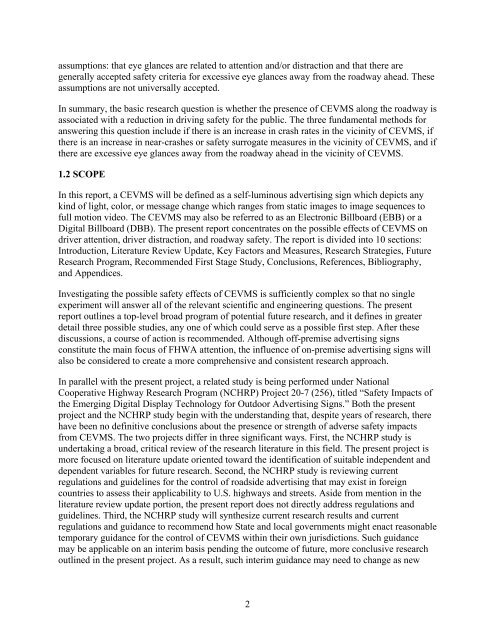The Effects of Commercial Electronic Variable Message Signs ...
The Effects of Commercial Electronic Variable Message Signs ...
The Effects of Commercial Electronic Variable Message Signs ...
Create successful ePaper yourself
Turn your PDF publications into a flip-book with our unique Google optimized e-Paper software.
assumptions: that eye glances are related to attention and/or distraction and that there are<br />
generally accepted safety criteria for excessive eye glances away from the roadway ahead. <strong>The</strong>se<br />
assumptions are not universally accepted.<br />
In summary, the basic research question is whether the presence <strong>of</strong> CEVMS along the roadway is<br />
associated with a reduction in driving safety for the public. <strong>The</strong> three fundamental methods for<br />
answering this question include if there is an increase in crash rates in the vicinity <strong>of</strong> CEVMS, if<br />
there is an increase in near-crashes or safety surrogate measures in the vicinity <strong>of</strong> CEVMS, and if<br />
there are excessive eye glances away from the roadway ahead in the vicinity <strong>of</strong> CEVMS.<br />
1.2 SCOPE<br />
In this report, a CEVMS will be defined as a self-luminous advertising sign which depicts any<br />
kind <strong>of</strong> light, color, or message change which ranges from static images to image sequences to<br />
full motion video. <strong>The</strong> CEVMS may also be referred to as an <strong>Electronic</strong> Billboard (EBB) or a<br />
Digital Billboard (DBB). <strong>The</strong> present report concentrates on the possible effects <strong>of</strong> CEVMS on<br />
driver attention, driver distraction, and roadway safety. <strong>The</strong> report is divided into 10 sections:<br />
Introduction, Literature Review Update, Key Factors and Measures, Research Strategies, Future<br />
Research Program, Recommended First Stage Study, Conclusions, References, Bibliography,<br />
and Appendices.<br />
Investigating the possible safety effects <strong>of</strong> CEVMS is sufficiently complex so that no single<br />
experiment will answer all <strong>of</strong> the relevant scientific and engineering questions. <strong>The</strong> present<br />
report outlines a top-level broad program <strong>of</strong> potential future research, and it defines in greater<br />
detail three possible studies, any one <strong>of</strong> which could serve as a possible first step. After these<br />
discussions, a course <strong>of</strong> action is recommended. Although <strong>of</strong>f-premise advertising signs<br />
constitute the main focus <strong>of</strong> FHWA attention, the influence <strong>of</strong> on-premise advertising signs will<br />
also be considered to create a more comprehensive and consistent research approach.<br />
In parallel with the present project, a related study is being performed under National<br />
Cooperative Highway Research Program (NCHRP) Project 20-7 (256), titled “Safety Impacts <strong>of</strong><br />
the Emerging Digital Display Technology for Outdoor Advertising <strong>Signs</strong>.” Both the present<br />
project and the NCHRP study begin with the understanding that, despite years <strong>of</strong> research, there<br />
have been no definitive conclusions about the presence or strength <strong>of</strong> adverse safety impacts<br />
from CEVMS. <strong>The</strong> two projects differ in three significant ways. First, the NCHRP study is<br />
undertaking a broad, critical review <strong>of</strong> the research literature in this field. <strong>The</strong> present project is<br />
more focused on literature update oriented toward the identification <strong>of</strong> suitable independent and<br />
dependent variables for future research. Second, the NCHRP study is reviewing current<br />
regulations and guidelines for the control <strong>of</strong> roadside advertising that may exist in foreign<br />
countries to assess their applicability to U.S. highways and streets. Aside from mention in the<br />
literature review update portion, the present report does not directly address regulations and<br />
guidelines. Third, the NCHRP study will synthesize current research results and current<br />
regulations and guidance to recommend how State and local governments might enact reasonable<br />
temporary guidance for the control <strong>of</strong> CEVMS within their own jurisdictions. Such guidance<br />
may be applicable on an interim basis pending the outcome <strong>of</strong> future, more conclusive research<br />
outlined in the present project. As a result, such interim guidance may need to change as new<br />
2

















